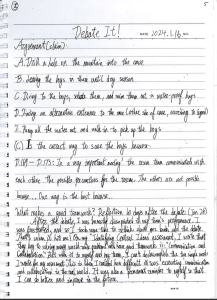In the most current unit in humanities, we learned about literary non-fiction. A genre of books that tells real stories of people who experienced great lives, or events that shaped our world, and impacts our lives in every aspect! In this unit we dived deep, not only were we simply reading to understand the text, but also we engaged thoroughly with background knowledge that led to further the understanding the complicated issues and how our world operates.
My Notebook Pages:
- This is one of the humanities summative assessments in this unit. The goal was to let construct a claim to explain central idea in our books, and use 4 pieces of evidence/quotes from the book to support the claim. In this assessment, my claim was communication and collaboration ultimately led to the success of the rescue mission. And I supported it with 4 strong pieces of claim throughout the book. The rescue team communicated And even took it to the next level by using an example from Chinese history of how 3 countries communicating and collaborating with one another lead to peace and wealth. Overall, the central idea assessment is my synthesis page where I summed up all of the pieces of ideas from different lessons and combined them into one page. I also did a reflection on my summary on the townhall debate notebook page.

- Before the central ideas assessment, there was a townhall debate, which every bookclub presented its book and one argumentative claim about it. Our group decided it would make a great argument if we listed all the possibilities for the rescue mission, and argue that the way that the rescue team used in the end was the best strategy. Also on the page was a reflection I did 10 days after the debate. It was after the central ideas assessment, where I concluded that the 2 major reasons of the rescue mission’s success was communication and collaboration. When I looked back at my own team’s debate, I realized that we also lacked a lot of communication and collaboration, and how the two simple words are so hard to follow.

- On this page records my notes of descriptive passages. I first did an example on “Hidden Figures”, the sample text in class. Then I got to work myself, finding many sections in the book where descriptive language was used. The two chosen ones that were written on the notebook because they were the ones that described the setting and scene of the story most to me. Overall, I think “All Thirteen” had great descriptions of setting and environment, paired with the pictures, I can get a big picture and fully understand how the rescue mission is going throughout the storyline.

- This page is about expecting and tracking complexity (combined into one lesson), and I first did this by writing about where and when to expect complexity in the book. After that, I made a web diagram myself to track the storyline and sequence of events that occurred. Additionally, I added another section of the diagram that shows what would happen if the rescue team arrived late. There could’ve been a lot more possibilities to the story, but I think this is the best one to record down because it proves how communication was important all throughout the story.
Intro of All Thirteen:
“All Thirteen” by Christina Soontornvat, is my bookclub book and how I learned about literary non-fiction. The story is based on the Thai Soccer team that got stuck in a local cave in 2018. Although many of us know about the rescue and are familiar with the news titles. “All Thirteen” gave an overall summary, analysis, and storyline look of the rescue mission. The key question are: how did the soccer team managed to survive inside the cave for almost 2 weeks without food? And how did the rescue team come up with a hyper effective and efficient plan to rescue the boys from the cave?
